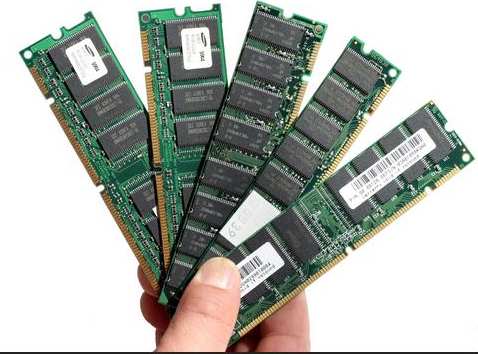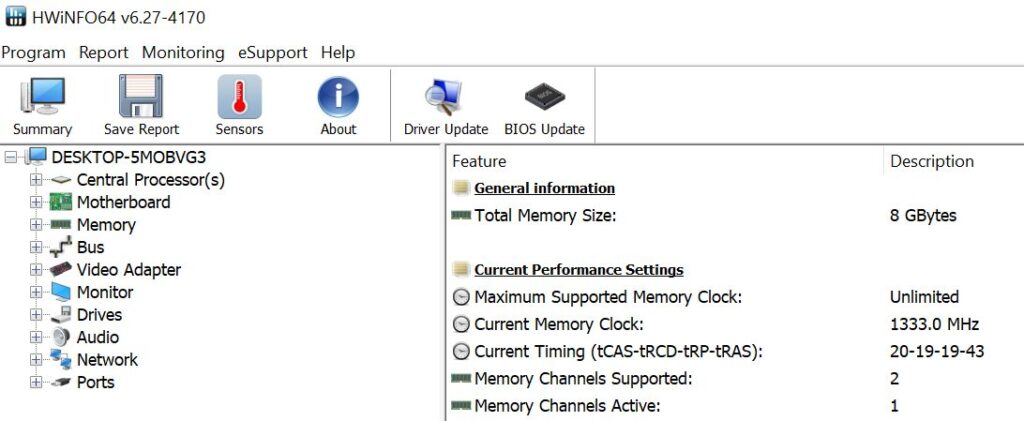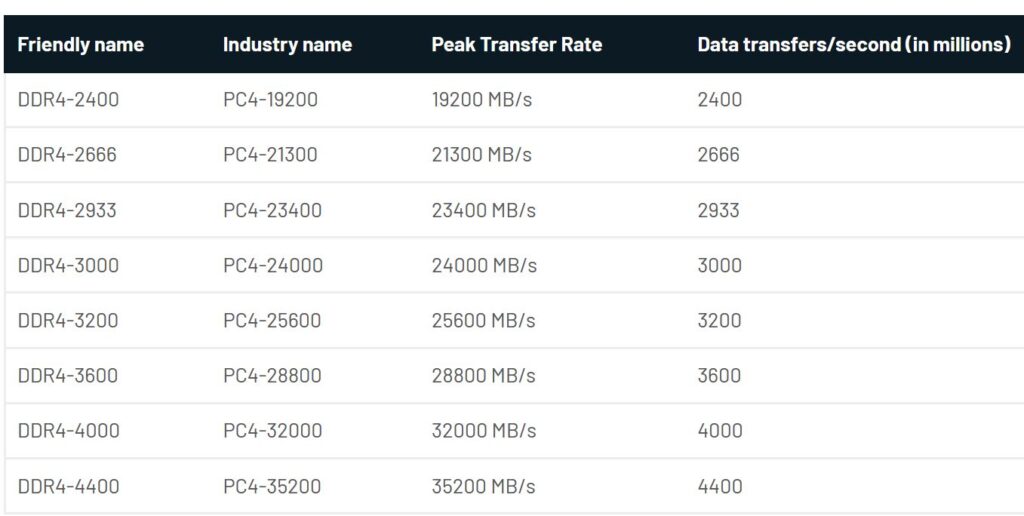
There are currently four types of DDR (Double Data Rate) RAM memory that desktop and laptop PCs use – DDR, DDR2, DDR3 and DDR4. The latest type in widespread use is DDR4.
Note that
tThe release date for DDR5 memory was July 14, 2020, but it will take a fairly long time until Intel and AMD adopt it for their processors and the motherboard manufacturers respond by releasing boards that support it. DDR5 memory does not run on a motherboard that uses DDR4 memory. It is wholly new technology and requires its own platform. If the DDR5 motherboard has the same processor socket as a DDR4 motherboard, you can use the processor from it in a DDR5-supporting motherboard.
DDR5 memory uses much less power, produces significantly higher performance levels and packs four times the capacity of DDR4 memory on to each DIMM memory module. A DDR4 memory module, a has a maximum capacity of 32GB. A DDR5 module maxes out at 128GB per module. A huge increase in capacity. A system using four DDR5 modules has 512GB of memory compared to the 128GB of a DDR4 system.
What is DDR5? The PC’s next-gen memory, explained [September 2021] –
https://www.pcworld.com/article/3632356/what-is-ddr5.html
The processors that support those four types are made by AMD and Intel. A particular make/model of motherboard can only run a processor made by AMD or Intel, never both. The latest processors of both of those major processor manufactures support DDR4 memory. Therefore, if you want to buy a desktop or laptop PC or build your own desktop PC by installing the components in an ATX case, it must have DDR4 memory as its memory specification.

The DDR interface transfers data on both the rising and falling edges of a single clock signal
The Double-Data-Rate (DDR) interface transfers data on both the rising and falling edges of a single clock signal, in effect doubling the data bus bandwidth without a corresponding increase in clock frequency. The operating system – Windows, Apple’s iOS X, Linux, Android, etc. – runs the memory, which requires no software device drivers.
The image below is a reading by the HWINFO64 tool of the DDR4 RAM memory of a desktop PC with 8GB of DDR4-2666 (PC4-21300) 21300 MB/s 2666 memory. The current memory clock is shown as running at 1333MHz, but the speed is effectively double that data rate, hence the 2666 in the specification.

Installation of DDR4 RAM memory
For installation instructions, visit the How to install DDR/DDR2/DDR3/DDR4 RAM memory that is part of the Build Your Own PC section of this website.
If you have the user manual that came with a motherboard you bought or which can be downloaded from its manufacturer’s website, it provides all of the information about that particular model, such as how to install memory, the capacities that the memory DIMM slots support, how to install the drives, the processor, how to connect the motherboard to the power supply unit, etc. Some motherboards provide onboard diagnostic LED lights that indicate if a component is working or not.
What happens if you install incompatible DDR4 RAM memory
If you install memory that is incompatible, the computer will not boot and you won’t even be able to enter the UEFI BIOS. Only the processor’s fan and the case fans fans will function.
I always buy Crucial memory for desktop and laptop PCs by using the Crucial System Scanner, a download that scans a system in order to provide compatible memory, or by using the Crucial System Advisor that does much the same by entering the make/model of the computer or its motherboard. The memory that both methods recommend is guaranteed to work with the device or you get a refund.
A PC motherboard can only run one type of DDR memory
A PC motherboard can only run one type of DDR RAM memory.at its various speeds/frequencies. – Memory is backward-compatible but only within its generation type. That means you can add faster memory of one DDR type (e.g. DDR4) to a computer that was designed to run slower memory of that same DDR type. Unfortunately, the system will operate at the speed of its slowest memory module.
Earlier DDR, DDR2 and DDR3 memory is still available for older systems, but those types only run on old motherboards.
The link below goes to a page on the crucial.com website that provides all of the Crucial DDR RAM memory that the MSI B450M PRO-M2 MAX supports. It is all guaranteed to work on that make/model of motherboard.
https://uk.crucial.com/compatible-upgrade-for/msi-%28micro-star%29/b450m-pro-m2-max#memory
The names and data-transfer rates of DDR4 memory
The table below shows the names and data-transfer rates of DDR4 RAM memory. The higher the data-transfer rate is in seconds, the faster the memory is. Memory gets more expensive the higher its capacity, measured in gigabytes (GBs) , and the faster it is. DDR4-2666 memory is fine for a workstation. A home user would only buy DDR4- 4400 for a gaming PC that must have a motherboard that supports it.

The informative video below uses the following terms:
Double-channel and quad-channel memory configurations
Double-channel and quad-channel memory configurations. are features that the memory and its motherboard must support. The dual-channel configuration operates by using two identical memory modules in alternative slots (if there are four slots) so that they run as a single module. microATX (mATX) motherboards only have two memory slots, therefore can only run in dual-channel mode, but only if the memory modules are identical. Full-size ATX motherboards usually have four memory slots.
MSI® B450M PRO-M2 (mATX) motherboard:
2x DDR4 memory slots, support up to 32GB
Supports DDR4 1866/ 2133/ 2400/ 2667 MHz by JEDEC,
and 2667/ 2800/ 2933/ 3000/ 3066/ 3200/ 3466 MHz by
A-XMP OC mode*
Dual channel memory architecture
If the motherboard and processor support a quad-channel memory configuration, all four modules are run as a single module.
The website of the make/model of the motherboard running the memory provides a User Manual that provides information on the compatible memory and how to use it in a particular configuration.
XMP and AMD memory profiles
Extreme Memory Profiles (XMP) is an Intel technology, that, if available on an Intel platform, allows the memory to be overclocked (run at speeds higher that the stock default speed) by setting an XMP profile in the BIOS. AMD Memory Profiles (AMP) is AMD’s version. There is a small increase in performance at best if such a profile is set, but probably isn’t worth the trouble that can result, so is best avoided.
What Is XMP Profile and How to Enable It to Speed up RAM –
https://www.partitionwizard.com/partitionmagic/what-is-xmp.html
Computer RAM questions answered –